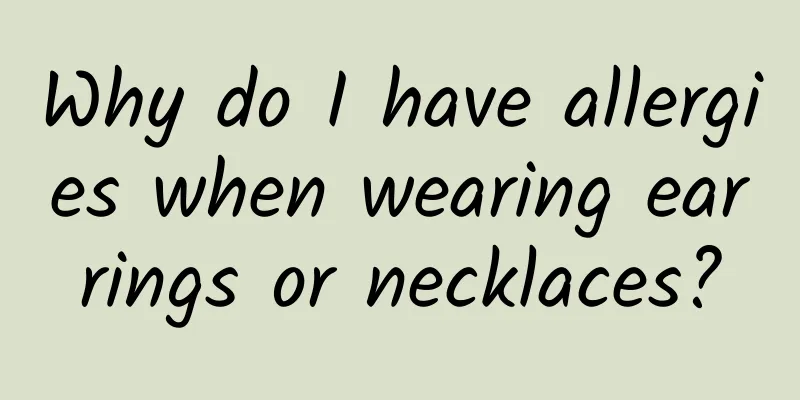Why do I have allergies when wearing earrings or necklaces?

|
Earrings and necklaces are very common jewelry. Unfortunately, not everyone can enjoy the beauty of these jewelry, because some people will experience skin redness, swelling and itching after wearing them. Figure 1. Skin allergy after wearing a necklace (Source: https://ar.inspiredpencil.com/) What is mentioned above is the phenomenon of metal jewelry allergy, which is also called contact dermatitis in medicine. In fact, this problem caused by metal is very common. Today, let’s talk about what metal allergy is and how to identify and deal with it. What is a metal allergy? Metal allergy, as the name suggests, is an allergic reaction of the human immune system to certain metal elements, which manifests on the skin as the "contact dermatitis" mentioned above. The mechanism of metal allergy is relatively complex. It is mainly caused by the binding of specific metals (such as nickel) to skin cells, activating immunity (the immune system mistakes the metal for an invader), thereby triggering a series of inflammatory responses. The occurrence of metal allergy varies greatly from person to person. Some people are "allergic saints" and are naturally allergic to metal jewelry. This is medically called "individual genetic quality." In addition, whether or not you are allergic is also affected by many other factors, such as whether the skin barrier is intact, the time and frequency of contact with metal jewelry. For example, in a hot and humid environment, sweating on the skin will accelerate the release of metal ions, making it more likely to cause an allergic reaction. Nickel: The metal that causes trouble Among the metals that cause allergies, the most common and suspected metal component is nickel. There is even a special name for contact dermatitis caused by nickel, called "nickel dermatitis." Figure 2. Temporal dermatitis caused by wearing a ring (Source: https://ar.inspiredpencil.com/) Other metals can occasionally cause problems, as we discuss below. nickel Nickel is the most common allergenic metal. It is not only stable and corrosion-resistant, but also cheap and has high gloss, so it is very popular in the industry and widely used in earrings, necklaces, watches, glasses frames, belt buckles, smart bracelets and other accessories. Figure 3. Allergies caused by the metal parts of the bracelet (containing nickel) (from references) Studies have shown that nickel ions are more easily dissolved in sweat, so wearing nickel-containing jewelry in summer or in humid environments is more likely to cause allergies. chromium Chromium is also a common allergenic metal, widely found in jewelry, zippers, belt buckles and other items. Chromium is highly irritating to some people's skin, and can easily cause symptoms such as skin redness, swelling and peeling after contact. In addition, chromium is also commonly used in the dyeing and processing of leather products, so contact with certain leather products may also cause allergies. cobalt Cobalt is commonly used in blue dyes and metal alloys, and although it is less common than nickel and chromium, it can occasionally cause skin allergies. Items containing cobalt include certain metal jewelry, tile pigments, and medical devices, and long-term exposure to these items may cause inflammatory reactions in the skin for people with cobalt allergies. Gold and Palladium Gold and palladium are generally considered inert metals, but in some cases they can also trigger allergic reactions, especially in individuals with long-term wear or sensitive immune systems. For such allergies, it may be necessary to avoid wearing low-purity metal items. The following symptoms indicate metal allergy Medically, metal allergy is a typical delayed allergic reaction. Its characteristic is that after the first contact, only the internal immune response allows the body to produce specific T cells, which are responsible for identifying and processing foreign substances. Symptoms will only occur after the next contact with the allergic metal, and contact dermatitis will occur. Because of this, symptoms usually occur within a few days of initial exposure to the metal, but some people may not develop symptoms until after multiple exposures. So, what are the specific symptoms? We have summarized the following table for your reference. Table 1. Common symptoms of metal allergy symptom describe Redness and swelling A red rash appears on the skin at the contact site, often accompanied by slight swelling and with clear borders Blisters In severe cases, blisters of varying sizes may form on the surface of the skin erythema, and local exudation and scabs may also occur. dry In the later stages, inflammation gradually subsides, and the skin may become dry, peeling, or even pigmented. Itching The itching sensation is usually more obvious and uncomfortable. pain When the rash is sudden and severe, it may occasionally be painful However, it is important to note that the symptoms of metal allergies vary and may present differently depending on individual differences. If the diagnosis is uncertain, it is best to see a dermatologist for further evaluation. Doctors will generally check the details of the rash, ask whether the patient has come into contact with any special items, and learn about the circumstances of the disease. Doctors can use these clues to comprehensively determine whether the patient is allergic to metal. If the symptoms are atypical and difficult to diagnose, or if you want to know the specific allergic component, we can use allergen testing to assist in diagnosis. This allergen testing is specifically referred to as "patch testing." Figure 4. Patch test (Source: https://mascotspincontrol.in/) The patch test is a reliable skin testing method. The specific steps are that the doctor sticks patches containing different common allergenic metals on the patient's skin (usually the back), and observes whether the skin reaction appears redness and swelling after 24 to 48 hours, and the degree of redness and swelling, so as to determine whether there is a metal allergy and the severity of the allergy. Through this method, it is possible to identify which metals will cause allergies so that patients can avoid these allergens in their daily lives. Can I still wear jewelry if I have metal allergies? Many people have a misunderstanding and think that they have to say goodbye to all jewelry if they are allergic to metal. In fact, this is not the case. We can have it both ways (wear jewelry and have healthy skin). Here are some steps you can take: Choose jewelry that does not contain allergenic metals: Avoid jewelry that you are allergic to, and choose jewelry made of sterling silver, 18K gold, pure titanium or platinum instead, as these metals are less likely to cause allergic reactions. Of course, you can also consider switching to non-metallic jewelry, and the specific choice depends on personal preference. Use protective coating: The next best option is to apply a layer of colorless nail polish on the surface of the metal jewelry that you are allergic to, which can isolate the metal from direct contact with the skin to a certain extent. However, this is risky because this coating may wear off with wear and needs to be reapplied regularly. If you still have recurrent allergies after doing this, it is best to replace it. Keep your skin clean: Keep your skin clean and dry before and after wearing jewelry, and avoid wearing nickel-containing jewelry for a long time after sweating, in order to reduce the release of metal ions. It would be better if you can use moisturizing products regularly, because studies have shown that this helps maintain a healthy skin barrier function. How to repair skin after metal allergy? Medically, there are many ways to treat metal allergies. If the allergy is mild and does not seriously interfere with normal life, you can choose topical medications for treatment. The most commonly used are a variety of glucocorticoid ointments, such as desonide cream, hydrocortisone butyrate cream, mometasone furoate cream, etc. They can control skin inflammatory reactions and indirectly relieve itching. Generally, it takes a few days to 1 or 2 weeks to cure allergies. However, it is best to see a doctor about how to choose the best ointment, the details of how to use it, and when to use it. It is not recommended to take medicine blindly because the medicine may occasionally have side effects. If the symptoms are more severe, such as obvious swelling and itching over a large area, oral antihistamines (commonly known as anti-allergic drugs) are sometimes added, such as loratadine, cetirizine, etc. They have some additional help in alleviating allergy symptoms. Summarize Finally, to summarize, metal allergy is a common contact dermatitis, mainly caused by jewelry containing nickel (especially obvious), chromium, cobalt and other metals. Understanding the causes, symptoms and preventive measures of metal allergies can help us reduce the risk of allergies when wearing jewelry. For people with known metal allergies, choosing low-allergenic jewelry materials is the key to prevention. In addition, when allergic symptoms occur, it is best to stop wearing the relevant jewelry in time and receive treatment under the guidance of a doctor to avoid aggravating skin damage. References [1] Levian B, Chan GC, Adler BL. Out of REACH: Allergic contact dermatitis to nickel in an Apple Watch. Contact Dermatitis. 2024; 90(1): 99-101. [2] Litchman G, Nair PA, Atwater AR, et al. Contact Dermatitis. Treasure Island (FL): StatPearls Publishing; 2024. [3] UpToDate. Management of allergic contact dermatitis in adults. https://www.uptodate.com/contents/zh-Hans/management-of-allergic-contact-dermatitis-in-adults. Author: Tang Jiaoqing, MD, attending physician of dermatology Reviewer: Feng Jun, deputy chief physician of the Dermatology Department of Sinopharm Tongmei General Hospital The article is produced by Science Popularization China-Creation Cultivation Program. Please indicate the source when reprinting. |
<<: Stay away from malnutrition, cancer patients also need to manage their lives well every day
>>: Does men's skin age faster than women's?
Recommend
Qingbitang: Autumn care for rhinitis patients, how to prevent and control the worsening of the disease
The weather is getting colder, the temperature is...
Is medical abortion better for women or surgical abortion?
How should women who are pregnant unexpectedly ha...
How to treat vulvar leukoplakia effectively?
Vulvar leukoplakia is a very common gynecological...
Pictures of submucous uterine fibroids
Uterine and cervical fibroids are one of the most...
Symptoms of abnormal leucorrhea in girls
In fact, we need to spend time taking care of our...
What vegetables are good for breast enhancement?
In fact, we know that if a woman has flat breasts...
Smoking and hypertension: How primary care physicians can effectively manage patients
Hypertension is a chronic disease that puts const...
Active nutrition, eat away the diseases caused by eating
If you want to prevent the seeds of chronic disea...
Eczema during pregnancy is more likely to cause a boy
Some pregnant mothers are more concerned about th...
What are the benefits of skipping rope for women?
Nowadays, more and more people pay more attention...
Red granules on vulva
The female vulva is a very sensitive and fragile ...
What are the recipes for postpartum meals?
Many postpartum women pay special attention to th...
Is it okay to have sex on the last day of my period?
Women's menstruation has a characteristic. Ma...
What color is anesthesia?
Comic Creation: Zhimatang The popular science the...









